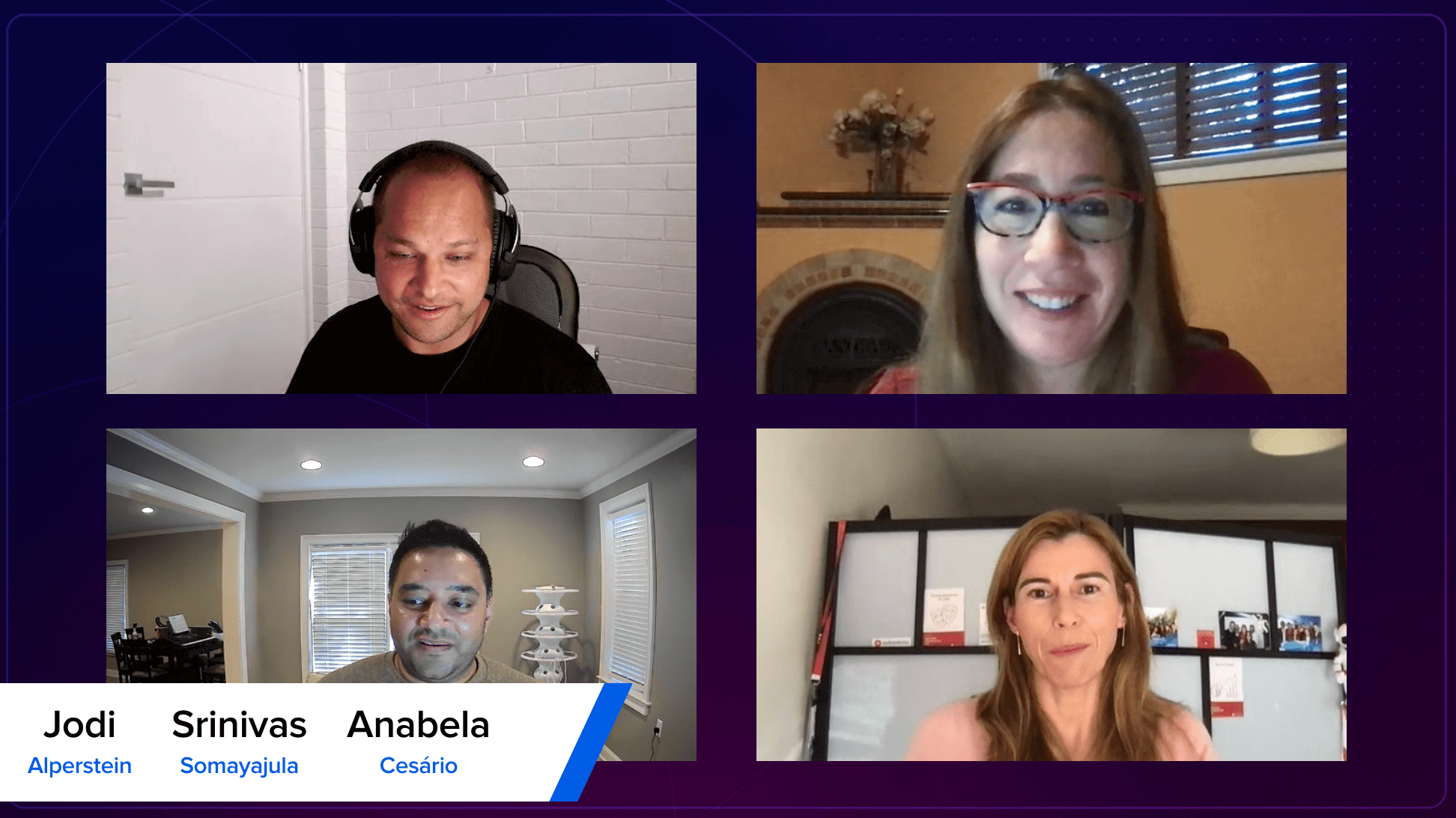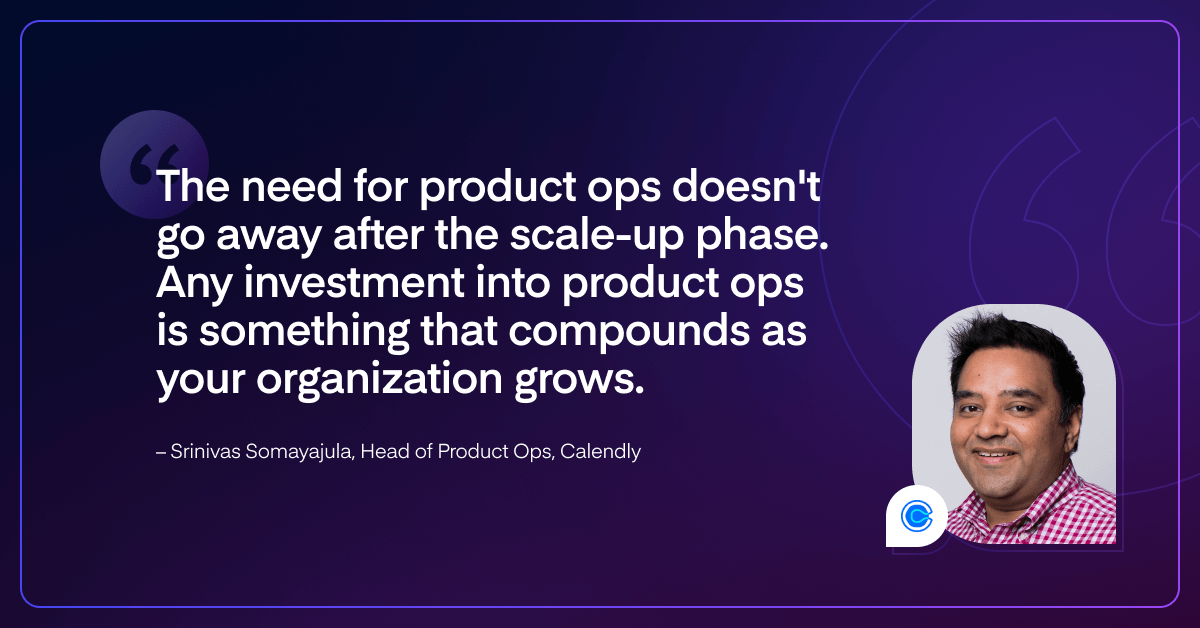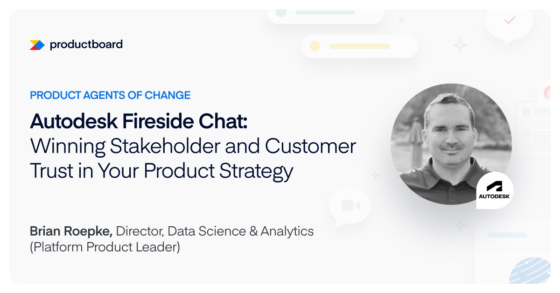Building and scaling successful product ops teams

Building a successful product organization is a lot like cooking, says Anabela Cesário, Director of Product Ops at OutSystems. Making lasagna for 100 people as opposed to a family of four is not just about increasing the amounts of ingredients you use. You also need to streamline some processes (and get better tools) or else you’ll end up with a giant mess.
It’s the same for your product org. Piling on new product managers and teams might help you scale initially, but it’s not a long-term solution. You also need to create systems and processes so these teams can work well with each other and other stakeholders.
This is why in recent years we’ve seen the rise of the product ops function. What exactly is product ops and how can it help keep your product house in order? Check out this panel discussion from the Product Excellence Summit, featuring: Simon Hilton, Director of Product Ops at Willow, Srinivas Somayajula, Head of Product Ops at Calendly, Jodi Alperstein, VP & GM at Twilio-Segment, and Anabela Cesário, Director of Product Ops at OutSystems. Read on for a lightly edited transcript of their conversation.
Watch the recording of their discussion here.
Simon: Starting product ops is a daunting journey, but it’s not unique. There are patterns of support out there, so it’s going to be great to share that with the rest of the Summit today. A lot of organizations have different perspectives on what product ops is or isn’t, so let’s summarize how we’re defining product ops ourselves.
Anabela: For me, product ops is all about communication, alignment, and processes across the product development lifecycle. It’s about enabling our product managers to build better products. I understand that it can be very easy to get overwhelmed in this sea of challenges as a product ops professional, especially because we’re in a position where we act as the glue for all the stakeholders.
I strongly believe that we aren’t supposed to boil the ocean, but to find an operating model that allows us to be more focused on what really moves the needle and matters. Right now for me and my team, we are focused on three main pillars: help the PM org scale, deliver business objectives, and improve cross-team communication.
“For me, product ops is all about communication, alignment, and processes across the product development lifecycle. It’s about enabling our product managers to build better products. Anabela Cesário, Director of Product Ops, OutSystems”
Jodi: For us, product ops is very similar. It is responsible for ensuring that the product development lifecycle is operating efficiently and effectively and helping the teams scale, so they create both programs that are used across the board as well as individual product operations managers that support our specific teams with launches.
And it also involves communication and connective tissue between the development of a product and rolling it out to the go-to-market teams and ensuring a smooth launch, bringing together product marketing, sales enablement, etc.
Simon: Is there anything that product ops isn’t that we need to be aware of?
Srinivas: Our product ops charter at Calendly is really all about creating exponentially impactful product teams that deliver great products. When I talk to other peers in this space about what it isn’t, they agree that it is not a catch-all of all the things a product team does not want to do — that is a risk that comes to life depending on where the inception of product ops comes from. So being really mindful of creating a charter and rationalizing what it is and isn’t is super important.
“Product ops is not a catch-all of all the things a product team does not want to do. ”
Simon: It also depends on where your product is in terms of its growth journey. It’s got to be focused for it to be effective. What was the catalyst inside your organization for starting product operations?
Jodi: We started product ops fairly recently, about a year ago. As Segment was starting to grow and scale, we realized we needed this help. We brought in a single product operations manager and she just came in and created all sorts of frameworks and efficiencies and programs in order to help the team, and we instantly realized we’d been missing this all along.
And then we got lucky in that Segment became part of Twilio. And with that, we saw an existing framework that was out there in Twilio, so we had something to emulate. We also had the additional budget to be able to invest deeply, so we added a couple more product ops managers at the beginning of this year and we’ve been scaling it ever since.
Every team is now clamoring for that level of support. I think that’s a great way to think about it. When you start doing great work and adding a significant contribution, the other teams start saying, ‘I want to put my budget toward a product ops person’ vs. another engineer or another product manager. And when your team is having that level of impact, you know you’re doing something right.
Anabela: For us, it all comes to one word: hypergrowth. Imagine that you are cooking. Making a lasagna for four people is not the same as doing it for 20 or 100 people. Sometimes it’s not about doubling the doses of ingredients, but understanding the complexity and knowing that now there are many more pieces that can go wrong.
It’s the same for a product management team. We need to scale very fast. Suddenly our processes are not very useful anymore. Our tools are deprecated, they don’t help us anymore. And especially communication across the company is harder and harder every day.
For us, it became clear that as we were growing, we needed to give time for product managers to focus on the things that are more important—the product and the customers. And that was how product operations started at Outsystems, to help PMs during this journey.
“For us, it became clear that as we were growing, we needed to give time for product managers to focus on the things that are more important—the product and the customers. And that was how product operations started at Outsystems. ”
Srinivas: As a hypergrowth entity, we knew we needed to invest in more efficiency and effectiveness. As we continued to grow, we saw a user base with a lot of asks around what they wanted out of the product. And we were still building a product team, customer success teams, marketing teams. So while those teams were being built, we needed somebody to be the connective tissue to make sure we were effectively coordinating to meet customers where they were—whether that’s in product-oriented things or enabling the product to support teams like customer success and sales to ease the burden on them. And adding that overhead to a product manager can get really expensive, so having an entity that’s coordinating and being that connective tissue in a hypergrowth environment is basically how we landed on creating product ops as an organization.
Simon: There seem to be some common themes—you’re an organization, you’re in hypergrowth, you have multiple products and/or multiple teams, which makes it much harder to create alignment, but there’s another theme, which is product managers have so much to do day-to-day. We have research, stakeholder communication, working with delivery teams.
The more you can enable services for those teams, the more they can focus on the critical tasks of the product manager, which can be good decision-making—what should we build and why? That’s where product ops can really shine—in a fast-moving environment where you’re really serving product managers in that context.
Product ops seems logical—why do you think it’s taken so many organizations so long to come around to this realization, especially now that it’s more common to have things like sales ops and marketing ops?
Anabela: I think marketing and sales are pretty mature areas compared to product management. PMs in startups were seen as the superheroes who were able to do everything, to wear all the hats, speak with customers, participate in sales meetings, sit with the solution architect, and design the solution. But this is not possible anymore.
As companies scale, it’s really hard for PMs to deal with everything, to wear all the hats, and product ops tends to help by sharing some of the hats and bringing focus to the PMs to deal with the processes and tools. Product ops makes product managers’ and stakeholders’ lives easier.
Jodi: I think often the product manager is considered what we call the DRI, the directly responsible individual, the person held fully accountable for the success of a product. And in doing that, they often do exactly what Anabela said—they go in and wear any hat that needs to be worn in order to ensure the success of their product. And at some point, that just collapses on itself.
When you think about the scale and consistency as your organization grows, if every product team does everything differently, it becomes very challenging to bring things out to market.
You get to that point where the scale is there and as you bring in people with a specific skill set, magic starts to happen because they’re really focused on the thing that they love, and that they’re great at. Working together in collaboration across those teams yields incredible results.
“I think often the product manager is considered what we call the DRI, the directly responsible individual—the person held fully accountable for the success of a product...they go in and wear any hat that needs to be worn in order to ensure the success of their product. And at some point, that just collapses on itself. ”
Simon: What are the critical pieces to have in any successful product ops organization?
Anabela: Start by laying the foundations to help the PM function scale. Everything that can bring more efficiency to the PM—processes, best practices, tooling—so they can focus on core competencies. In our case, PMs were losing a lot of time handling customer feedback. Each one had their own spreadsheet. Also prioritizing initiatives and planning launches—we did it in a huge Excel spreadsheet so we had a lot of inefficiencies in the system.
Next, is to focus on communication. Create empathy with your stakeholders. Improve cross-team communication. Now we are doing it with product strategy, roadmap deployment, and monitoring metrics.
Finally, focus on business objectives and outcomes.

Simon: One thing that’s coming up in the chat is, isn’t that the same as a project or program manager? I’d say that there’s a distinction between doing the work and designing how the work gets done to enable consistency, transparency, scale. Srinivas, what do you think are the successful parts of a product ops org?
Srinivas: It sounds very much like a program or project manager, but it’s really about creating scalable practices and owning the tooling and enablement around those as opposed to being assigned a project with a start and end date or driving the business outcome or program with a start and end date.
“There are flavors of product ops that smell and taste like program and project management, but it’s really about scaling the practices so there’s consistency, predictability, and efficiency across the delivery lifecycle.”
Our product operations charter is anchored around a couple of key things:
- Clarity around the product goals, objectives, and outcomes.
- Analytics and research. I think we’ve all seen it when biases can be introduced in the product development lifecycle, so our product ops function owns unbiased analytics and research to support product delivery.
- Process excellence. What does the assembly line look like? If an idea pops up from a customer, how does it go through the entire assembly line and actually make it into the hands of customers at the right targets and objectives that we set for ourselves?
- Communication and coordination. Our product ops managers are aligned to specific pods we have in our organization, but also aligned to external teams, like customer experience and sales.
- Learning and growth. If our charter is, “Create exponentially impactful product teams,” it’s not just about building a great product, it’s also enabling the product manager to be as effective as possible. We support our individual product managers on development plans as well as the product organization holistically around identifying the strengths and weaknesses and how to bring everybody up from a maturity perspective.
Simon: That’s a great point. It’s actually about uplifting the entire product organization and that can include what a good product manager looks like at our organization.
Jodi: One of the things we haven’t talked about yet is change management. As you’re putting in new programs and new efficiencies, I’ve seen some great ideas fall flat if they are not rolled out correctly and you don’t bring everybody along.
“One of the things we haven’t talked about yet is change management. As you’re putting in new programs and new efficiencies, I’ve seen some great ideas fall flat if they are not rolled out correctly and you don’t bring everybody along.”
Sometimes that means you start out with a pilot and then you get more people on board. Sometimes you’ve got to do it all at once to make sure everyone is doing the same thing, using the right tool for the right scenario. I also think things like direct communication, inclusive collaboration, and clear roles and responsibilities are key.
Everywhere I’ve worked, whether it be product management or product marketing or product operations, there’s a slight variation on how things are done, so people come into new organizations with their experience from the past and find that things aren’t exactly the way they were at their last company. You need to make sure that your programs and processes are clear, otherwise you’ve got people stepping on each other’s toes. You might have a bunch of people swarming the ball instead of playing their own positions, and that wreaks some havoc vs. the efficiency that we’re looking for.
Measurable goals, making sure that there’s an actual business impact, and that whole piece around effective tools and frameworks are key. Sometimes there does need to be a little bit of leeway. If everything is so controlled, the teams themselves don’t feel empowered to create their best work. It’s important to create a space for product teams to be really creative and excel.
Simon: You can suffocate or constrict your organization if you don’t give them the freedom to innovate. The way I’ve framed it within my organization is we unite people with processes and tools, we create cross-organizational alignment, and we make the right data easily available. Everyone’s largely on the same page. But it’s not cookie-cutter, either. There are going to be different ways of implementing things based on how big your company is, how long its been around, how mature your product is.
As organizations shift from startup to scaleup to enterprise maturity, how have you seen those teams change?
Anabela: It’s easier when we come from a product management role and we understand the practice. For me, PMs are my customers and I always think about how I can measure adoption, collect feedback, etc.
I started with a team of three that focused on building the foundations, tools, processes, and so on, and then we moved more to the communication piece. We dedicated someone to inbound communication (managing all the insights from stakeholders across the company), and someone to outbound (product roadmap updates, enablement, field enablement, etc).
Now we are moving to a more strategic role, supporting the VP on strategy definition and deployment. We’re focused on growing our PM talent. In the hypergrowth phase we’re in, the majority of our PMs come from the startup mindset so they need some help and guidance to understand this new way of doing product. We’ve set up an internal B2B product management academy where we’re bringing in gurus like Bruce McCarthy, Marty Cagan, and Melissa Perri to tailor the training for us. So far we’ve had four sessions and they are really working well.
Simon: How does product ops actually make your team scale and operate faster?
Anabela: When we started in March 2020, the relationship with stakeholders—especially the field teams, the solution architects, and the sales teams—was really fragile. But, we ended the year with the CSAT (customer satisfaction score) of 86%. And this was mainly because we sat with them and defined an end-to-end engagement process. They felt much more involved and they felt that the PM really listened to them.
The second was adopting Productboard. Implementing Productboard improved the productivity of the PM team by 30%. When we were selecting the tool, we listed the top six PM use cases and were able to address them in Productboard. And the results are visible because PM and engineering teams are now able to understand the product strategy. They now use Productboard on a daily basis to make product decisions.
We have a lot to evolve and improve, but this is really visible. Stakeholders are talking and justifying decisions by connecting the initiative to the product strategy, so it’s really interesting to see how we’re helping them with the product narrative.
Jodi: We need to look at Productboard. We’ve kind of missed that piece so far. We’re going directly from Salesforce to Jira and missing the purpose-built product tool, but I do think our product ops teams have done a good job of working with what already exists.
We were putting product requests into Salesforce and they would kind of sit there. Product managers would go in and look things up, but we hadn’t really figured out how to scale it and operationalize it. We got an email once a week with all of the different requests that came through and then you had to parse through it in a very ad-hoc way, so a key thing that one of the product ops managers on the team did was to create a dashboard that it made it really easy for everyone to see what’s in Salesforce. Then we linked every single request in Salesforce to the Jira tickets.
We wanted to make it so that our salespeople had the tools to fish for themselves and make sure those two systems were talking to each other. Now our sales folks don’t just feel like they put something in there but never get a response back.
Simon: It’s very encouraging to hear how we’re all planning similar things inside our organizations, where we’re aligned and where we differ, but it’s clear that product ops can be useful at any stage of any organization and Productboard can be a great place to drive that growth along. Thank you everyone for your time and have a great day.
Access the full discussion here.





